Kushinagar
Kushinagar is an important Buddhist pilgrimage site, where Buddhists believe Gautama Buddha attained Parinirvana after his death. It is an international Buddhist pilgrimage centre. The followers of Buddhism, especially from Asian countries, wish to visit this place at least once in their lifetime.
Kushinagar | |
|---|---|
Town | |
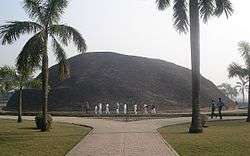 Ramabhar Stupa was built over a portion of the Buddha's ashes on the spot where he was cremated by the ancient Malla people. | |
 Kushinagar Kushinagar in Uttar Pradesh  Kushinagar Kushinagar (India) 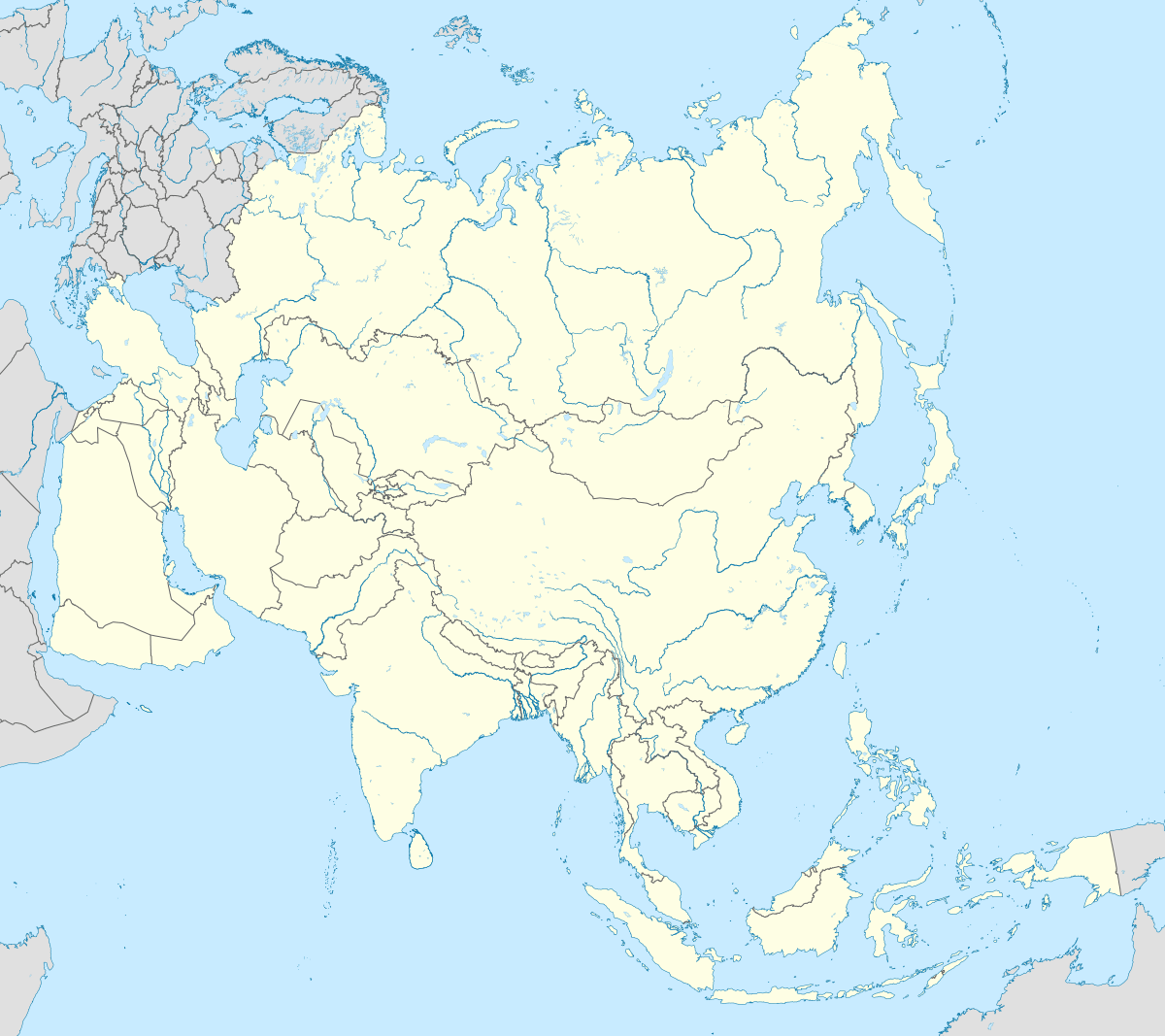 Kushinagar Kushinagar (Asia) | |
| Coordinates: 26.741°N 83.888°E | |
| Country | |
| State | Uttar Pradesh |
| District | Kushinagar |
| Government | |
| • Type | Nagar Palika |
| • D.M. | Bhupendra S. Chaudhary |
| • A.D.M | Bindhvasani Rai |
| • MP | Vijay Kumar Dubey (BJP) |
| Population (2011)[1] | |
| • Total | 22,214 |
| Language | |
| • Official | Hindi[2] |
| • Additional official | Urdu[2] |
| Time zone | UTC+5:30 (IST) |
| Vehicle registration | UP 57 |
| Website | www |
| Pilgrimage to |
| Buddha's Holy Sites |
|---|
 |
| The Four Main Sites |
| Four Additional Sites |
| Other Sites |
|
| Later Sites |
|
Etymology
According to one theory, Kushvati was the capital of Kosala Kingdom and according to Ramayana it was built by King Kush, son of Rama, protagonist of the epic Ramayana. While according to Buddhist tradition Kushavati was named prior to the king Kush. The naming of Kushwati is believed to be due to abundance of Kush grass found in this region.[3]
Demographics
According to 2011 Indian Census, Kushinagar had a total population of 22,214, of which 11,502 were males and 10,712 were females. Population within the age group of 0 to 6 years was 2,897. The total number of literates in Kushinagar was 15,150, which constituted 68.2% of the population with male literacy of 73.3% and female literacy of 62.7%. The effective literacy rate of 7+ population of Kushinagar was 78.4%, of which male literacy rate was 84.5% and female literacy rate was 71.9%. The Scheduled Castes and Scheduled Tribes population was 1,117 (5.03%) and 531 (2.39%) respectively. Kushinagar had 3462 households in 2011.[1]
History
The present Kushinagar is identified with Kusavati (in the pre-Buddha period) and Kushinara (in the post-Buddha period). Kushinara was the capital of Mallas which was one of the sixteen mahajanpads of the 6th century BCE. Since then, it remained an integral part of the erstwhile empires of Maurya, Shunga, Kushana, Gupta, Harsha, and Pala dynasties.
In the medieval period, Kushinagar had passed under the suzerainty of Kultury Kings. Kushinara continued to be a living city till the 12th century CE and was thereafter lost into oblivion. Padrauna is believed to be ruled over by a Rajput adventurer, Madan Singh, in the 15th century CE.
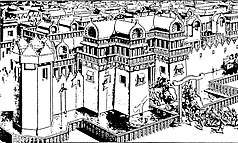
However, modern Kushinagar came into prominence in the 19th century with archaeological excavations carried out by Alexander Cunningham, the first Archeological Surveyor of India and later followed by C.L. Carlleyle who exposed the main stupa and also discovered a 6.10 meters long statue of reclining Buddha in 1876. Excavations continued in the early twentieth century under J. Ph. Vogel.[4] He conducted archaeological campaigns in 1904-5, 1905-6 and 1906-7, uncovering a wealth of Buddhist materials.
Chandra Swami, a Burmese monk, came to India in 1903 and made Mahaparinirvana Temple into a living shrine.
After independence, Kushinagar remained part of the district of Deoria. On 13 May 1994, it came into being as a new district of Uttar Pradesh.[5]
Location of Gautama Buddha's death and parinirvana
In 1896, Waddell suggested that the site of the death and parinirvana of Gautama Buddha was in the region of Rampurva.[6] However, according to the Mahāyāna Mahāparinirvāṇa Sūtra, the Buddha made his journey to Kushinagar, died there, and this is where he was cremated.[7][8] It is believed that during his last day he walked into the groves of trees near the city and rejoiced at the blossoms of sala trees (Shorea robusta) before laying himself to rest.[9]
Modern scholarship, based on archaeological evidence, believes that the Buddha died in Kushinagar, close to the modern Kasia (Uttar Pradesh).[10][11][12][13][14]
Ashoka built a stupa and pilgrimage site to mark Buddha's parinirvana in Kushinagara.[15] The Hindu rulers of the Gupta Empire (fourth to seventh century) helped greatly enlarge the Nirvana stupa and Kushinagar site, building a temple with reclining Buddha.[16][17] This site was abandoned by Buddhist monks around 1200 CE, who fled to escape the invading Muslim army, after which the site decayed during the Islamic rule in India that followed.[18][19] The British archaeologist Alexander Cunningham rediscovered Kushinagara in the late 19th century, and his colleague A. C. L. Carlleyle unearthed the 1,500-year-old Buddha image.[17][20][21] The site has since then become an important pilgrimage site for Buddhists.[7][22] Archaeological evidence from the 3rd century BCE suggests that the Kushinagara site was an ancient pilgrimage site.[7]
Geography
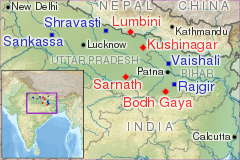
Kushinagar is a nagar palika situated at 53 km east from Gorakhpur on the National Highway-28, lying between latitude 26°45´N and 83°24´E. Gorakhpur is the main railway terminus for Kushinagar while air strip of UP Civil Aviation is situated in Kasia, 5 km away from Kushinagar, currently being developed as an International Airport by Uttar Pradesh Government and Government of India.[23]
Tourism
Parinirvana Stupa
.jpg)
The reclining Nirvana statue of the Buddha is inside the Parinirvana Stupa. The statue is 6.10 metres long and is made of monolith red sandstone. It represents the "Dying Buddha" reclining on his right side with his face towards the west. It is placed on a large brick pedestal with stone-posts at the corners.[24]
Nirvana Chaitya (Main Stupa)
Nirvana Chaitya]is located just behind the Main Parinirvana Temple. It was excavated by Carlleyle in the year 1876. During excavations, a copper plate was found, which contained the text of the "Nidana-Sutra" which concluded the statement that plate had been deposited in the Nirvana-Chaitya by one Haribala, who also installed the great Nirvana Statue of Buddha in the temple front.[24]
Ramabhar Stupa Ramabhar Stupa, also called a Mukutbandhan-Chaitya, is the cremation place of Buddha. This site is 1.5 km east of the main Nirvana Temple on the Kushinagar-Deoria road.[24]
Matha Kuar Shrine A colossal statue of Lord Buddha is installed, which is carved out of one block which represents Buddha seated under the "Bodhi Tree" in a pose known as "Bhumi Sparsh Mudra" (Earth touching attitude). The inscription at the base of statue is datable to the 10th or 11th century A.D.[24]
Other major places
- Indo-Japan-Sri Lanka Temple: Indo-Japan-Sri Lanka temple is a marvel of Buddhist architectural grandeur of modern times.[24]
- Wat Thai Temple: It is a huge complex built in a typical Thai-Buddhist architectural fashion.[24]
- Ruins and brick structures: These are located around the main Nirvana Temple and Main Stupa. These are the remains of various monasteries of different sizes constructed from time to time in the ancient period.[24]
- Several museums, meditation parks and several other temples based on architecture of various eastern countries.
The Government of Uttar Pradesh has proposed the Kushinagar-Sarnath Buddha Expressway to connect Buddhist pilgrimage towns. The expressway will be around 200 km long and will reduce the distance from both town from Seven hours to one and half hours.
Government and politics
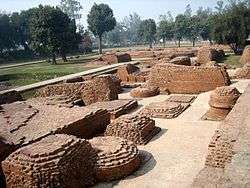
Kushinagar comes under Kushinagar Lok Sabha constituency for Indian general elections. The Member of Parliament from this constituency is Vijay Kumar Dubey of Bharatiya Janata Party 2014 Indian general elections who was elected in the 2019 Indian general election.
As of 2019, the Member of Legislative Assembly (MLA) from Kushinagar Assembly constituency is Rajnikant Mani Tripathi of Bharatiya Janata Party.
Notable people
- Dharikshan Mishr, Bhojpuri language poet
- Sachchidananda Vatsyayan 'Agyeya', noted Hindi writer
- Ram Nagina Mishra, former Lok Sabha MP
- Baleshwar Yadav, former Lok Sabha MP
- Rajesh Pandey, member of 16th Lok Sabha, also served as a Member of Legislative Council in Uttar Pradesh
- R. P. N. Singh, former member of parliament from Indian National Congress, also served as Minister of State for Road and Transport, Minister of State for Petroleum and Natural Gas in the cabinet of former Prime minister, Dr. Manmohan Singh
Gallery
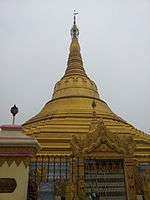 Mahasukhamdada Chin Thargyi Pagoda (Burmese Temple)
Mahasukhamdada Chin Thargyi Pagoda (Burmese Temple)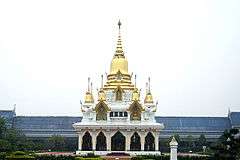 Wat Thai Temple
Wat Thai Temple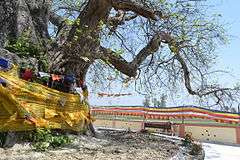 Buddha relic distribution site
Buddha relic distribution site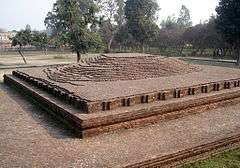 Buddha's body was kept at this location for one week, after he attained Parinirvana.
Buddha's body was kept at this location for one week, after he attained Parinirvana.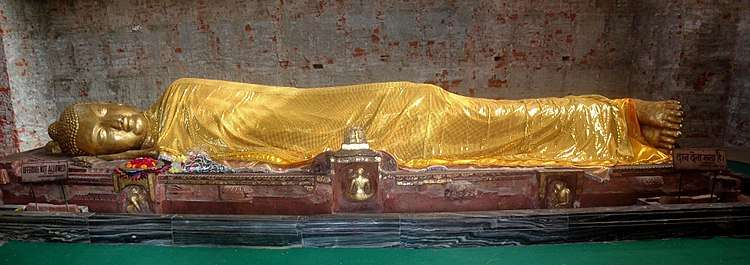 Gautama Buddha's statue in Parinirvana, at the Mahaparinirvana Temple
Gautama Buddha's statue in Parinirvana, at the Mahaparinirvana Temple Ramabhar Stupa was built over a portion of the Buddha's ashes on the spot where he was cremated by the ancient Malla people.
Ramabhar Stupa was built over a portion of the Buddha's ashes on the spot where he was cremated by the ancient Malla people..jpg) Relief on the base of a Buddhist statue
Relief on the base of a Buddhist statue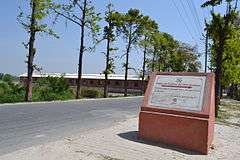 Stone plaque pointing towards Buddha relic distribution site
Stone plaque pointing towards Buddha relic distribution site
See also
References
- "Census of India: Kushinagar". www.censusindia.gov.in. Retrieved 29 December 2019.
- "52nd REPORT OF THE COMMISSIONER FOR LINGUISTIC MINORITIES IN INDIA" (PDF). nclm.nic.in. Ministry of Minority Affairs. p. 49. Archived from the original (PDF) on 25 May 2017. Retrieved 10 February 2019.
- "History". Kushinagar District. 20 November 2017.
- Vogel J Ph. (1950). "Some Buddhist Monasteries in Ancient India". Journal of the Ceylon Branch of the Royal Asiatic Society. 1: 27–32.
- "Kushinagar History". kushinagar.nic.in. Retrieved 18 July 2015.
- "A Tibetan Guide-book to the Lost Sites of the Buddha's Birth and Death", L. A. Waddell. Journal of the Asiatic Society of Bengal, 1896, p. 279.
- Lars Fogelin (2015). An Archaeological History of Indian Buddhism. Oxford University Press. pp. 23–24. ISBN 978-0-19-994822-2.
- John Guy (1991). "The Mahabodhi temple". The Burlington Magazine. 133 (1059): 356–357. JSTOR 884751.
- S., Bhattacharya (1996). Buddh for the young (1st ed.). New Delhi: National Book Trust, India. p. 42. ISBN 81-237-2006-8.
- United Nations (2003). Promotion of Buddhist Tourism Circuits in Selected Asian Countries. United Nations Publications. pp. 23–24. ISBN 978-92-1-120386-8.
- Kevin Trainor (2004). Buddhism: The Illustrated Guide. Oxford University Press. p. 41. ISBN 978-0-19-517398-7.
- Elizabeth Lyons; Heather Peters; Chʻeng-mei Chang (1985). Buddhism: History and Diversity of a Great Tradition. University of Pennsylvania Museum of Archaeology. p. 17. ISBN 978-0-934718-76-9.
- Fred S. Kleiner (2009). Gardner's Art through the Ages: Non-Western Perspectives. Cengage. pp. 13, 31. ISBN 978-0-495-57367-8.
- Huntington, John C (1986), "Sowing the Seeds of the Lotus" (PDF), Orientations, September 1986: 47, archived from the original (PDF) on 28 November 2014
- Akira Hirakawa; Paul Groner (1993). A History of Indian Buddhism: From Śākyamuni to Early Mahāyāna. Motilal Banarsidass. p. 101. ISBN 978-81-208-0955-0.
- Gina Barns (1995). "An Introduction to Buddhist Archaeology". World Archaeology. 27 (2): 166–168. doi:10.1080/00438243.1995.9980301.
- Robert Stoddard (2010). "The Geography of Buddhist Pilgrimage in Asia". Pilgrimage and Buddhist Art. Yale University Press. 178: 3–4.
- Richard H. Robinson; Sandra Ann Wawrytko; Ṭhānissaro Bhikkhu (1996). The Buddhist Religion: A Historical Introduction. Thomson. p. 50. ISBN 978-0-534-20718-2.
- Mark Juergensmeyer; Wade Clark Roof (2011). Encyclopedia of Global Religion. SAGE Publications. p. 148. ISBN 978-1-4522-6656-5.
- Asher, Frederick (2009). "From place to sight: locations of the Buddha´s life". Artibus Asiae. 69 (2): 244.
- Himanshu Prabha Ray (2014). The Return of the Buddha: Ancient Symbols for a New Nation. Routledge. pp. 74–75, 86. ISBN 978-1-317-56006-7.
- Lars Fogelin (2006). Archaeology of Early Buddhism. AltaMira Press. pp. 42–43. ISBN 978-0-7591-1444-9.
- "Kushinagar geography". kushinagr.nic.in. Retrieved 18 July 2015.
- "Places in Kushinagar". kushinager.nic.in. Retrieved 17 July 2015.
Further reading
- A Literary History of Deoria & Kushinagar by M.A. Lari Azad (USM 1998 Ghaziabad)
- Patil, D R (1981). Kusīnagara, New Delhi : Archaeological Survey of India.
External links
| Wikivoyage has a travel guide for Kushinagar. |
| Wikimedia Commons has media related to Kushinagar. |
- Official Photo Gallery of Kushinagar
- Entry on Kusinara (Kushinagar) in the Dictionary of Pali Proper Names
- Kushinagar, Archaeological Survey of India, Sarnath Circle